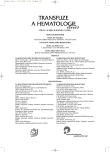Impact of preparative regimen and haematopoietic stem cell transplantation on circulating markers of cardiac damage
Authors:
J. M. Horáček 1,4; R. Pudil 2; L. Jebavý 1,4; M. Tichý 3,4; A. Štrasová 1; P. Žák 1; J. Malý 1
Authors‘ workplace:
I. interní klinika – Oddělení klinické hematologie, Fakultní nemocnice Hradec Králové a Lékařská fakulta Univerzity
Karlovy v Hradci Králové
1; I. interní klinika, Fakultní nemocnice Hradec Králové a Lékařská fakulta Univerzity Karlovy v Hradci Králové
2; Ústav klinické biochemie a diagnostiky, Fakultní nemocnice Hradec Králové a Lékařská fakulta Univerzity Karlovy
v Hradci Králové
3; Katedra válečného vnitřního lékařství, Fakulta vojenského zdravotnictví Univerzity Obrany v Hradci Králové
4
Published in:
Transfuze Hematol. dnes,12, 2006, No. 3, p. 153-159.
Category:
Comprehensive Reports, Original Papers, Case Reports
Overview
Introduction:
Cardiac toxicity is a relatively frequent and potentially serious complication of treatment in hematooncology. Anthracyclines and high-dose chemotherapy represent the greatest risk. Various methods including measurement of circulating markers have been recommended for monitoring of cardiotoxicity of oncology treatment.
Aim:
Assessment of cardiotoxicity during preparative regimen (PR) and haematopoietic stem cell transplantation (HSCT) in acute leukemia (AL) with circulating markers – N-terminal pro brain natriuretic peptide (NT-proBNP), cardiac troponin T (cTnT) and creatine kinase MB (CK-MB mass).
Patients and methods:
Nineteen adult patients treated for AL (mean age 42.8±10.0 years, 13 males) were studied. The patients were pretreated with anthracyclines in the cumulative dose (CD) of 446.1±91.6 mg/m2. PR consisted of high-dose Cyclophosphamide 120 mg/kg (HD-C) and Busulphan 16 mg/kg in 13 patients, HD-C and fractionated total body irradiation 12 Gy (TBI) in 6 patients. Ten patients underwent allogeneic HSCT, 9 patients autologous HSCT. Plasma NT-proBNP, cTnT and CK-MB mass concentrations were measured the day before PR, the day after PR, the day after HSCT and 14 days after HSCT, i.e. at the time of bone marrow recovery.
Results:
The day before PR, mean plasma NT-proBNP value was 106.3±55.7 pg/ml (slightly elevated in 4 patients). The mean NT-proBNP increased to 426.1±391.5 pg/ml after completion of PR. After HSCT, a further increase to 847.6±780.6 pg/ml was observed. Fourteen days after HSCT, the mean NTproBNP was 330.8±236.8 pg/ml, values remained elevated in 12 patients. The differences were statistically significant in comparison with the baseline NT-proBNP (p < 0.01). The NT-proBNP elevations were more pronounced in patients with CD of anthracyclines above 450 mg/m2 (p < 0.05), in patients with PR containing HD-C and TBI (p<0.05) and in patients undergoing allogeneic HSCT (p < 0.05). In all patients, plasma cTnT and CK-MB mass concentrations remained negative during PR and HSCT.
Conclusions:
Our results suggest that administration of PR and HSCT is in most AL patients associated with acute neurohumoral activation (significant rise in NT-proBNP). Persistent NT-proBNP elevations, in our study in 12 (63.2 %) patients, indicate subclinical cardiotoxicity (risk for
development of heart failure) and require further follow-up. More pronounced NT-proBNP elevations in patients with higher CD of anthracyclines and in patients with PR containing combination of high-dose chemotherapy and radiotherapy confirm that these therapeutic procedures seem to be more cardiotoxic and not very appropriate for patients with cumulation of risk factors for cardiotoxicity. Negative plasma cTnT and CK-MB mass concentrations show no detectable damage of cardiomyocyte structure during PR and HSCT.
Key words:
cardiotoxicity, circulating markers, preparative regimen, transplantation, acute leukemia
Labels
Haematology Internal medicine Clinical oncologyArticle was published in
Transfusion and Haematology Today

2006 Issue 3
Most read in this issue
- Splenectomy in diagnostics and treatment of hematological disorders: A single-center indications, complications and results
- Plasma concentrations of cytokines and co-stimulatory molecules (interleukins IL-2, IL-4, IL-5, IL-6, IL-8, IL-10, IL-13, TNF-α, TGFβ1, sCD23, sCD40L and IL-6 receptor) in healthy blood donors
- The standardization of a biochemical laboratory determination of multiple myeloma
- New approaches to diagnosis and treatment of iron overload
